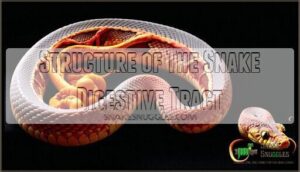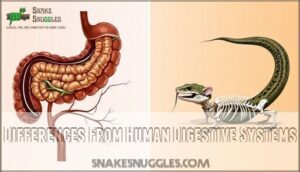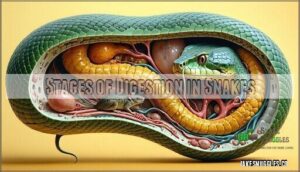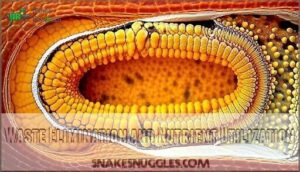This site is supported by our readers. We may earn a commission, at no cost to you, if you purchase through links.
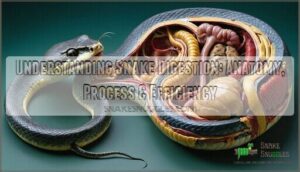
While your stomach expands maybe 30% after Thanksgiving dinner, a snake’s balloons to more than double its fasting size, and its metabolic rate explodes fortyfold to dissolve bones that would pass through most carnivores untouched.
The machinery behind this transformation—from hinged jaws to vanishing organs—reveals how snakes turned infrequent gorging into a survival advantage.
Table Of Contents
Key Takeaways
- Snakes can expand their stomachs by over 100% and increase their metabolic rate up to 44-fold after feeding, allowing them to digest prey whole—including bones—through stomach acid with pH levels as low as 1.5.
- The snake’s digestive organs actually shrink by more than half during fasting periods to conserve energy, then rapidly expand again when prey is consumed, making this reversible organ atrophy a key survival adaptation.
- Temperature directly controls digestion speed in snakes, with warm conditions (around 30-31°C) cutting processing time by over 40% compared to cooler temperatures, which is why snakes actively seek heat after eating.
- Snake digestion achieves 99.3-99.8% efficiency by breaking down nearly everything including bones, with specialized intestinal cells capturing excess minerals like calcium to prevent toxicity while extracting maximum nutrients from infrequent meals.
Snake Digestive Anatomy and Adaptations
When you look at a snake’s digestive system, you’re seeing nature’s answer to an extreme lifestyle—one built for swallowing prey whole and going weeks without another meal. From expandable jaws to a stomach that can dissolve bones, every part of this system shows how evolution shapes form to match function.
A snake’s digestive system is nature’s answer to an extreme lifestyle—built for swallowing prey whole and surviving weeks between meals
Let’s walk through the key anatomical features that make snake digestion so remarkably different from our own.
Structure of The Snake Digestive Tract
The snake’s digestive tract is an extraordinary assembly line that stretches nearly the entire length of its body, beginning at the buccal cavity and ending at the cloaca. The esophagus anatomy occupies up to half the body length, featuring internal folds that allow swallowing of massive prey.
You’ll find the stomach shape is distinctly J-shaped, secreting powerful acids.
The intestine divisions include the duodenum, jejunum, and ileum, where nutrients enter your bloodstream.
Expandable Jaws and Feeding Adaptations
What makes all this possible is a jaw that doesn’t just open wide—it practically dislocates on command. The upper jaw connects to the braincase through flexible ligaments, and the quadrate bone acts as a hinge, enabling independent movement of each jaw half.
This cranial kinesis allows you to witness snakes consuming prey twice their head diameter. Curved fangs grip firmly during swallowing, and the entire mechanism represents one of nature’s most efficient feeding adaptations.
Differences From Human Digestive Systems
Beyond those jaw mechanics, digestive system differences between snakes and humans are striking. You’ll notice snakes possess extreme stomach expansion capabilities—over 100% post-feeding—while human stomach volume remains relatively fixed. Their intestinal absorption skyrockets tenfold after meals, then downregulates during fasting. Snakes also utilize a cloaca for waste, unlike humans.
Consider these anatomical adaptations for digestion:
- Digestive speed: Snake fecal transit ranges from 48 hours to a year; humans average 24–72 hours
- Waste elimination: Snakes use a single cloacal opening; humans have separate exits
- Nutrient absorption in snakes: Intestinal villi rapidly expand post-meal for maximum efficiency
- Digestive process comparison: Snake stomach pH drops to 1.5 to dissolve bones; human acidity is moderate
- Human digestive system contrast: You eat multiple daily meals; snakes feast weeks apart
These adaptations reflect fundamentally different survival strategies.
Role of Oral Glands, Teeth, and Venom Glands
Your snake’s mouth isn’t just built for swallowing—it’s equipped with specialized glands, teeth, and in some species, venom apparatus that kickstart digestion before prey even reaches the stomach. Oral gland secretions coat prey with mucus-rich saliva, lubricating passage through the esophagus. Snake teeth—curved and backward-facing—secure struggling prey during swallowing.
Venom glands in venomous species inject proteolytic enzymes that break down muscle proteins, effectively pre-digesting tissue for faster nutrient absorption later.
Feeding Mechanisms and Prey Consumption
Before you watch a snake unhinge its jaw to gulp down dinner, you should understand the mechanics that make this possible.
Snakes have developed impressive feeding strategies that let them consume prey much larger than their heads. Let’s look at how they capture, position, and swallow their meals whole.
Strategies for Capturing and Swallowing Prey
Snakes don’t have the luxury of chewing their food—they’ve evolved a suite of capture and swallowing strategies that turn whole-prey consumption from impossible to routine. Here’s how prey detection and capture unfold:
- Ambush or active hunting: Snakes locate prey using heat sensors, chemical cues, or visual tracking before striking.
- Venom delivery or constriction methods: Venomous species inject toxins to immobilize prey, while constrictors use coiling pressure.
- Saliva lubrication: Coating prey aids swallowing through jaw flexibility and muscular effort.
Jaw Movement and Swallowing Process
Once prey is secured, the real show begins—a mechanical marvel where two halves of the jaw inch forward in alternating waves, pulling dinner down like a slow-motion conveyor belt. This "walking jaw" mechanism hinges on flexible ligaments that let each side move independently—no dislocation required, despite the myth.
Curved fangs anchor the prey while saliva lubricates its journey down the esophagus, where peristaltic contractions squeeze it toward the stomach.
Venom Use and Constriction Methods
Before prey even reaches the stomach, some snakes have already started the breakdown process—venom, in species that produce it, doesn’t just immobilize dinner but also contains proteolytic enzymes that begin digesting muscle tissue from the inside out.
Constrictor snakes take a different approach, applying measured force that stops blood flow and triggers asphyxiation within minutes.
Both strategies—whether venomous snakes inject biochemical cocktails or constrictor snakes apply mechanical pressure—evolved to simplify prey capture and kickstart digestion before swallowing begins.
Tradeoffs of Consuming Large Prey
When large meals go down, gape limitations become a life-or-death gamble—41% of deaths from excessive prey size prove this point. Consider these tradeoffs of prey consumption:
- Metabolic cost spikes up to seven-fold during digestion of large prey, draining energy reserves for weeks
- Digestive failure occurs when meals exceed 40% of body mass, leaving prey unprocessed
- Gape limitations cause fatal skin ruptures during swallowing attempts beyond physical capacity
- Foraging strategy determines risk exposure—ambush predators face longer, costlier digestion cycles than active hunters
These metabolic processes in snakes reveal ecological impacts that ripple through prey populations and predator survival rates alike. Ambush predators, however, often exhibit higher SDA metabolic scope compared to active predators.
Stages of Digestion in Snakes
Once your snake swallows its prey whole, the real work begins inside its body. The digestive process unfolds in distinct stages, each designed to break down everything from muscle tissue to bone.
Let’s walk through how stomach acid, intestinal enzymes, and specialized organs team up to extract nutrients from a meal that might sit in your snake’s gut for days or even weeks.
Stomach Acid and Enzyme Activity
Inside the stomach, a chemical transformation begins that would make even the toughest industrial solvents look weak by comparison. Your snake’s stomach secretes hydrochloric acid with pH levels low enough to dissolve bone, while specialized digestive enzymes target proteins in muscle and tissue.
This acid secretion creates an environment where protein breakdown happens rapidly, turning whole prey into absorbable nutrients through powerful enzymatic action.
Small Intestine Function and Nutrient Absorption
After the stomach’s acidic assault finishes its job, the small intestine becomes central as the real workhorse of nutrient extraction. This elongated structure divides into three segments—duodenum, jejunum, and ileum—where enzyme activity breaks down proteins, fats, and carbohydrates into molecules your snake’s body can actually use.
Specialized intestinal cells promote absorption of nutrients directly into the bloodstream, ensuring efficient nutrient uptake from even massive meals. The absorption rate depends partly on temperature, making this stage critical for overall small intestine function and successful bloodstream transfer.
Liver, Pancreas, and Gall Bladder Roles
Your snake’s digestive powerhouse doesn’t work alone—the liver, pancreas, and gall bladder coordinate behind the scenes to flood the small intestine with enzymes that finish what stomach acid started. The pancreas secretes lipases, carbohydrases, and proteases directly into the duodenum, while bile production from the liver breaks down fats.
This organ interdependence ensures your snake extracts maximum energy from each meal, with the liver also regulating metabolic processes by storing glycogen and managing nutrient distribution throughout the bloodstream.
Digestion of Bones and Resistant Materials
Bone digestion represents one of your snake’s most impressive metabolic tricks. Powerful stomach acid combined with proteolytic digestive enzymes dissolve calcium phosphate minerals and break down the organic matrix over several days. Burmese pythons use specialized cells with crypts that capture excess minerals, preventing calcium toxicity while bones vanish almost completely.
- Mineral absorption pulls calcium and phosphorus into the bloodstream for metabolic needs
- Specialized cells in the intestine sequester leftover minerals into particles for safe waste excretion
- Digestive efficiency reaches 99.3–99.8%, though indigestible keratin from hair forms pellets in feces
Metabolic Responses and Digestion Efficiency
When a snake swallows prey, its body shifts into high gear, triggering dramatic metabolic changes that make digestion possible. These physiological responses vary based on factors like meal size, temperature, and how long the snake has fasted.
Let’s look at the key metabolic adaptations that make snake digestion so efficient.
Metabolic Rate Changes Post-Feeding
When you feed a snake, you’re basically flipping a metabolic switch that transforms its entire physiology. The metabolic rate skyrockets dramatically after feeding, with some species showing increases of up to 44-fold above baseline levels. Peak metabolic timing usually occurs within 24 to 48 hours post-feeding, and this elevation persists for days or even weeks, depending on the meal size.
| Factor | Metabolic Response |
|---|---|
| Peak Timing | 24-48 hours post-feeding |
| Rate Increase | 2.8 to 44-fold above fasting |
| Energy Cost (SDA) | 17-32% of meal energy |
| Duration | 54-212 hours (meal-dependent) |
The specific action—the energy cost of digestion—consumes roughly 17-32% of the meal’s total energy content. Respiratory responses adapt accordingly, with cardiac output increasing four- to fivefold and oxygen consumption peaking within two days. Larger meals don’t just extend digestion time; they increase the entire postprandial response proportionally.
This striking digestion efficiency allows snakes to extract maximum nutrition from infrequent, massive meals.
Effects of Temperature on Digestion Speed
While metabolic shifts are impressive, temperature acts as the true throttle controlling how fast snakes digest their meals. Corn snakes at 20°C take 5.5 days to pass feces, but at 31°C they’re done in just 3.1 days—that’s over 40% faster. Temperature directly influences enzyme activity, with pepsin, amylase, and trypsin peaking around 30°C in most species.
Here’s how temperature shapes digestion:
- Thermoregulation benefits: Many snakes seek warmer spots after eating, raising body temperature by 0.9–1.2°C to accelerate digestion
- Enzyme activity: Digestive enzymes work fastest at 30°C, with activity plateauing beyond 33°C
- Digestive efficiency: Ranges from 85% at cooler temperatures to 89% at warmer ones in corn snakes
- Metabolic costs: Higher temperatures increase metabolic rate but reduce total digestion time, saving energy overall
- Seasonal adaptation: Rubber boas digest nearly twice as fast in summer compared to spring due to elevated body temperature
This temperature sensitivity explains why snakes bask after feeding—it’s not laziness, it’s strategic fuel management.
Organ Size Fluctuations During Fasting
When a snake doesn’t eat, its digestive organs shrink, sometimes by more than half their fed size. This atrophy mechanism conserves energy during months-long fasts, with the stomach and intestines losing mass while cellular changes reduce metabolic demands.
Your digestive system maintains a constant size, but snakes’ internal organs undergo reversible hypertrophy upon refeeding, expanding rapidly when prey arrives.
Postprandial Physiological Changes
After swallowing a massive meal, your snake’s body kicks into overdrive with a cascade of physiological shifts that rival the intensity of a marathon runner mid-race. Heart rate surges and oxygen consumption climbs four to six times above baseline as organs expand rapidly.
These metabolic responses transform a dormant predator into a digestion powerhouse, though temperature effects can alter processing speed dramatically.
Waste Elimination and Nutrient Utilization
After your snake’s digestive system breaks down its meal, the final stage involves eliminating waste and extracting every usable nutrient. The cloaca acts as the central hub for this process, managing both waste removal and water conservation.
Let’s examine how snakes process indigestible materials and optimize nutrient uptake, and compare their waste management to other animals.
Cloaca Function and Water Reabsorption
At the tail end of the digestive journey, the cloaca functions as a multipurpose chamber where waste elimination meets water conservation—an important adaptation for animals that may go weeks or months between meals. Here, the large intestines connect to extract remaining moisture from nitrogenous wastes before excretion.
You’ll find this hydration balance particularly important when snakes fast extensively. The cloaca anatomy allows efficient urate excretion while maintaining proper water reabsorption, preventing dehydration during prolonged periods without prey.
Excretion of Indigestible Materials
Even the most efficient digestive system can’t break down everything, leaving snakes to excrete pellets of resistant materials like hair, keratin, and excess calcium—byproducts of consuming prey whole. You’ll notice these waste pellets contain materials that resist enzymatic breakdown.
Specialized intestinal cells collect calcium and phosphorus from digested bones, allowing excretion through the cloaca without leaving bone fragments in feces. The large intestine completes this waste elimination process efficiently.
Nutrient Absorption Into The Bloodstream
Once nutrients from that digested prey break free from the small intestine’s chemical bath, they slip directly into your snake’s bloodstream, fueling everything from muscle repair to venom production.
The small intestine function relies on specialized cells that aid intestinal absorption through biochemical exchange. Digestive enzymes complete their work in the duodenum, enabling efficient nutrient uptake.
This bloodstream transport delivers amino acids, lipids, and glucose to tissues throughout your snake’s body.
Comparison to Other Vertebrate Digestive Systems
Snakes share core vertebrate digestive systems—mouth, stomach, intestines—but their gastrointestinal tract showcases extreme physiological differences. Unlike mammals that chew, your reptile digestion model involves swallowing whole prey, triggering dramatic metabolic shifts and organ expansion absent in most vertebrate functions.
This digestive evolution prioritizes system efficiency through feast-or-famine animal adaptations, contrasting sharply with the steady-state digestive process seen in birds or humans. The vertebrate comparison reveals snakes as metabolic specialists.
Frequently Asked Questions (FAQs)
How long can snakes survive without eating?
You might be surprised to learn that fasting duration for snakes can stretch from weeks to months, depending on species variation and environmental factors.
Their metabolic rate slows dramatically during food digestion gaps, allowing energy reserves to sustain them.
What happens if a snake eats poisonous prey?
Poison resistance in snakes varies by species. Most snakes can break down certain toxins during digestion, but bioaccumulation of prey poisoning affects snake health over time. Their digestive enzymes process some toxins better than venom from other snakes.
Do all snake species digest food similarly?
While the snake digestive system follows a similar blueprint across species, you’ll find digestive enzymes, metabolic rates, and digestion process efficiency vary widely. Dietary variations—from fish-eating water snakes to large-prey constrictors—drive distinct snake anatomy adaptations.
Habitat influence, size variation, and venom differences shape how each species processes meals, making snake physiology remarkably diverse.
Can snakes regurgitate meals after swallowing them?
Yes, snakes can regurgitate meals after they swallow them whole. Regurgitation triggers include stress, being held, illness, or temperature extremes that interrupt the digestion process.
This defensive mechanism wastes significant energy expenditure and carries health implications, as putrefaction of prey during digestion makes regurgitation particularly dangerous for your snake’s well-being.
How do baby snakes digest their first meals?
Like hatchlings emerging from protective shells into a world demanding immediate survival, baby snakes possess fully functional digestive systems from birth. Their maternal yolk digestion transitions seamlessly to processing prey as enzymes activate upon the first meal.
The initial gut microbiome establishes quickly, enabling neonate digestion rate to match adult efficiency despite their smaller size.
Conclusion
From jaw to cloaca, every structure in understanding snake digestion process reflects a singular evolutionary bet: get the most from prey you won’t see again for months.
The expandable stomach, acid strong enough to dissolve femurs, organs that shrink when idle—these aren’t curiosities but survival tools honed across millions of years.
Next time you watch a snake coil motionless after feeding, you’re witnessing biochemistry operating at extremes most vertebrates can’t approach.

